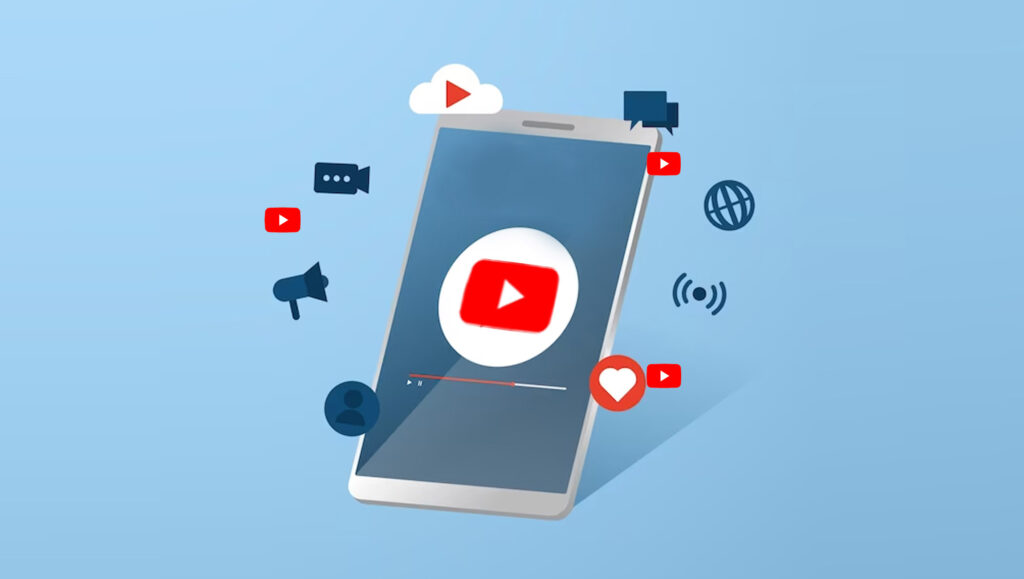Today, almost everyone who is active online is a YouTube viewer. With over 2 billion monthly active users, including over 75% of Americans aged 15 and older, YouTube is the second-most popular website behind Google.
Marketing your company on YouTube is a terrific idea because of the possibility of reaching a large audience. However, without a proper strategy, you won’t get far. Let’s take a deeper dive into the world of YouTube marketing.
Why is YouTube an established platform for content sharing?
The digital world has changed dramatically in recent years due to the exponential expansion of YouTube marketing and advertising. With billions of active users each month, YouTube has established itself as a leading platform for companies to connect with their target market. Companies use YouTube marketing to produce interesting and shareable content, building a passionate following for their goods or services.
Parallel to this, YouTube advertising has advanced, providing a variety of ad types such skippable commercials, display ads, and non-skippable ads, permitting companies to accurately target their audience based on demographics, interests, and browsing habits.
YouTube has become a vital tool for marketers because of the platform’s enormous popularity and sophisticated marketing options, which allow them to increase brand visibility, drive website traffic, and eventually boost conversion rates. It is projected that YouTube will continue to expand its influence in the marketing sector as it innovates and adjusts to shifting customer behavior.
What is YouTube marketing?
Marketing a business, product, or service via YouTube is called “YouTube marketing.”
A variety of strategies, including but not limited to:
- Producing natural promotional videos,
- Engaging influencers,
- Platform advertising
You should be aware of your consumers’ actual needs rather than your perception of what they would like, the latter is a trap that far too many companies fall into.
Additionally, you must ensure that the right audience sees your films. Because YouTube is a search engine, you must optimize your content just as you would for Google SEO goals.
Why is YouTube a successful marketing strategy?
With 22.8 billion monthly visitors, YouTube is the second most popular website in the world behind Google and may now offer a variety of advantages to businesses. In addition to being a well-known entertainment channel, the platform is a potent marketing tool, and businesses can create YouTube channels for advertising. YouTube channels aid in expanding a brand’s consumer base, increasing sales volume, and promoting a company or product in new geographies.
A practical instructional resource is YouTube. Greater visibility for businesses can increase their consumer base. Brands may improve their Google rankings by creating in-depth tutorials, live streaming, guides, and lectures. Another reason businesses utilize the online video-sharing service is to run advertisements since it enables their brands to reach a larger audience and attract new clients. Additionally, it costs much less money than paid advertisements on Facebook and Instagram.
It’s time to learn about YouTube’s primary advantages now that you know why it’s regarded as a powerful marketing tool.
Marketing Technology News: MarTech Interview with Paige O’Neill, CMO at Seismic
How Leading brands are using YouTube as a marketing channel?
Following are some illustrations of practical efforts followed by leading companies and brands. We will discuss what steps one can take and how leading brands implemented these steps to help make your YouTube marketing more successful.
Step 1: Identify Your Target Market
To design content that connects with them and increases the likelihood of engagement, start by understanding your audience’s needs, interests, and behaviors.
Examples of YouTube Marketing
According to Tubular Labs, the Old Spice channel’s most popular video is “Taking Stock.” It has received 61.6 million views and 40,500 engagements since its upload on February 4.
The Old Spice channel’s most popular video is the Man, Your Man, Could Smell Like. It has 277,000 engagements and 61.1 million views since being uploaded on February 5, 2010.
The two videos exemplify why customer intent has more influence than demographics. Women commonly buy body wash for men and frequently influence what men who shop for themselves buy, even though just 27% of the audience of the brand’s channel is female and 73% is male.
Old Spice has been able to provide exciting material catered to its targeted audience by developing a thorough grasp of its target client, their hobbies, and how they live and shop.
Step 2: Make a content strategy for the channel
Decide which of your brand’s goals should come first: loyalty, consideration, online or offline sales, and brand exposure.
The YouTube audience persona for your target demographic should include information about videos. Was it that they watched? What interests them?
Do some competition research. What chances do they pass up on YouTube? What do you hope to accomplish with this video campaign? Decide what success looks like. Decide on the right metrics to measure your progress.
Example of YouTube Marketing
The “Real Beauty Sketches” campaign from Dove was a risky experiment built on a content strategy to make sure the company’s material both engaged its target audience and satisfied its brand’s goals: to foster brand love and loyalty and to make women feel confident about their appearance rather than anxious about it.
Ogilvy & Mather Brazil’s film requested women to explain themselves to FBI-trained forensic artist Gil Zamora, who then sketched a portrait of the women based on their descriptions (from behind a mysterious curtain).
Step 3: Produce entertaining video content
Concentrate on producing video material that offers viewers intrinsic value. The four manifestations of this value are education, enlightenment, inspiration, and entertainment.
Example of YouTube Marketing
In India, many brands have perfected the art of longer-form video storytelling.
Look at this Samsung India video, “We’ll take care of you, wherever you are,” to see why you should concentrate on producing content that offers your consumers intrinsic value.
In this exciting video, a young Samsung Engineer handles a customer complaint in a distant, hilly place, unfazed by the challenging environment.
Step 4: Set a Content Schedule
Regularly post new videos to your website.
Build your programming strategy around:
- Helpful content—Videos that respond to your niche’s most common search terms.
- Hub material – Pre-written content released regularly gives viewers a reason to subscribe to your channel.
- Hero Content- The major marquee events intended to increase the size of your audience dramatically are known as “hero content.”
Example of YouTube Marketing
Businesses must act like media and entertainment companies when developing a programming plan. The Red Bull team is the best illustration of a YouTube marketing team that appreciates the power of content planning.
In a calendar year, the energy drink firm uploaded 4,676 clips to 45 YouTube channels in 14 countries. These videos received 34.1 million engagements and 1.2 billion (with a “b”) views.
For an example, look at “How Far Can A Reverse Soapbox Make It?”
Red Bull nevertheless posted “I Jumped From Space (World Record Supersonic Freefall)” to commemorate Baumgartner’s breathtaking space jump’s tenth anniversary.
Step 5: Improve Your Videos’ Searchability
Make sure to use relevant keywords in the titles and descriptions of your YouTube videos to increase their visibility in search results. Consider incorporating a call-to-action (CTA) into your movie to boost viewership and rate of conversion.
Example of YouTube Marketing
It’s essential to optimize your videos for search even if more people watch videos on the Home page and under Suggested Videos. Why?
Because YouTube search aims to present users with the most pertinent results based on keyword searches, one of the ranking elements is still how closely your video’s title, description, and content correspond to a user’s search.
So, video SEO is still effective.
For instance, the Rutgers Centre for Management Development (CMD) was hired in January 2011 by SonoSite, the industry pioneer in portable ultrasound equipment, to deliver a specialized version of its Mini-MBA: Digital Marketing course.
Step 6: Get Your Audience Involved
To create a strong community, reply to comments, address inquiries, and engage with your audience. Doing this may establish a solid rapport with your audience and keep them returning for more.
Example of YouTube Marketing
Sticky, an Australian candy manufacturer run by a family, has posted 598 films to YouTube in the last three years.
These videos have received 112 million engagements and 2.3 billion (with a “b”) views overall. An engagement rate of 4.9% equates to an average of 3.8 million views and 112,000 interactions per video.
“She Was Bragging Until..” is the Australian brand’s most watched and active video. There have been 210 million views and 9.0 million engagements on this brief video.
Step 7: Make use of influencer marketing
Join forces with well-known YouTubers who support your business and have a sizable following among your target market. This will raise your profile on the platform and enable you to reach new audiences.
Example of YouTube Marketing
The Influencer Marketing Benchmark Report predicts that by 2023, the influencer marketing market will be worth about $21.1 billion.
In the last 365 days, 47,000 sponsored videos have been uploaded to YouTube in 102 countries by 7,867 brand partners from 28 industries and 12,300 content partners from 21 genres, according to Tubular’s DealMaker.
Picking just one example seems arbitrary, whimsical, and capricious when there are so many to consider.
However, one of the most popular trending videos of 2022 was produced in collaboration with PayPal Honey by Jimmy Donaldson, also known as MrBeast. MrBeast challenges competitors to cross a chocolate river, scale a candy wall, play games with a confection theme, and indulge in their sugariest desires in a warehouse inspired by “Willy Wonka.”
Step 8: Make advertising investments
To target a particular audience and increase your channel’s views, subscribers, and interaction while increasing traffic to your website, think about employing YouTube’s paid advertising alternatives, such as video commercials or sponsored content.
Example of YouTube Marketing
Visit the YouTube Ads Leaderboard to view examples of the most popular advertisements viewers watch each quarter.
The 2022 year-end wrap-up’s top-ranking item was “Amazon’s Big Game Commercial: Mind Reader.” The media agency for this advertisement was IPG – Rufus, while the creative agency was Lucky Generals.
You may also look at YouTube success stories to learn how companies of all sizes use YouTube Ads to achieve their objectives. The instances highlight the objectives of each company. Then read about how video advertising helped the Missouri Star Quilt Company become the world’s largest retailer of precut quilting fabric if your goal is to raise brand awareness.
Read about how Ebates used video and search to increase awareness, boost consideration, and drive action when rebranded as Rakuten, even though “full-funnel marketing” is a misnomer.
Step 9: Experimental YouTube CTV campaigns
YouTube’s internal statistics show that users watch more than 700 million hours of its content on TV devices daily.
It would help if you did tests to discover how effective connected TV (CTV) might be for your audiences to comprehend the opportunity better.
Example of YouTube Marketing
You can’t know in advance as to what CTV advertising campaign will grab the right interest.
You can read Christine Turner’s article, “What three brands learned from their YouTube CTV experiments,” to learn more about the lessons brands are discovering.
In 2021, Frito-Lay North America sought to understand how Ruffle brand goals for brand awareness, and revenue were impacted by increased CTV watch time. Its marketing department conducted an A/B test, distributing half of the media spend across the typical devices and the other half with more money allocated to CTV. The group then contrasted performance and output.
Step 10: Measure Your Results
Use GA4, lift metrics, and YouTube Analytics to monitor key performance indicators (KPIs).
Make data-driven decisions based on data analysis to increase awareness, influence consideration, online or offline sales, and loyalty.
Here are three recent YouTube marketing campaigns that companies have employed to produce quantifiable results.
Sheikh Mohammed bin Rashid Al Maktoum, vice president, prime minister, and ruler of Dubai, launched the World’s Coolest Winter campaign to highlight the top tourism destinations in the United Arab Emirates as well as beloved Emirati cultural norms.
After the election, the campaign’s accomplishments were clear because they were outstanding. Hotel revenue jumped to AED 1.5 billion, representing a huge 50% rise from AED 1 billion the year before.
Additionally, the campaign brought in a mind-blowing 1.3 million tourists, a significant 36% increase over the first season. The campaign had a similarly impressive effect on hotel occupancy rates, which are anticipated to climb from 66% in 2021 to 73% in 2022, a staggering 7% increase.
Undoubtedly, the Coolest Winter campaign successfully promoted the UAE’s tourism sector and reinforced the fundamental principles of Emirati society.
How Are YouTube CTV Spends Surging?
Due to a number of variables, YouTube’s Connected TV (CTV) spending is soaring. First off, the number of CTV viewers on YouTube has significantly increased as a result of the shift in consumer viewing preferences from traditional linear TV to streaming platforms. As more users watch YouTube videos on their TV screens, advertisers have an excellent opportunity to reach a captive audience.
As more users watch YouTube videos on TV screens, marketers are placing greater value on YouTube’s Connected TV (CTV) inventory, especially during tentpole events. Advertisers are turning to CTV for its combination of TV screen brand awareness and digital audience targeting as the number of people watching linear TV declines and the number of people streaming increases.
Although YouTube has been emphasizing its CTV content to advertisers, some see a disadvantage in the upfront CTV-only package’s hefty price. Other people however, see value in using YouTube’s CTV platform to target a captive audience, particularly for important anniversaries and events. The CTV inventory on YouTube is particularly appealing to smaller marketers as an affordable entry point for TV advertising.
The benefits of CTV advertising, which combines the advantages of brand awareness on TV screens with the ability for precise targeting offered by digital advertising, are also becoming more and more well-known among advertisers. With the help of this combination, marketers may engage with their target audience in meaningful ways and improve the efficacy of their efforts.
Moreover, over the past few years, YouTube has been actively advertising its CTV inventory to advertisers. To expressly meet the rising demand, the platform has added CTV viewership to its upfront packages and provided CTV-only inventory packages.
Additionally, some advertisers, particularly bigger ones, see YouTube’s CTV inventory as a significant method to increase the effect and reach of their marketing initiatives during important occasions, such holiday campaigns and sponsorships of award shows.
The convergence of changing consumer behavior, more awareness of CTV’s advertising possibilities, YouTube’s promotional activities, and advertisers looking for meaningful risks during major occurrences have all led to the surge in spending on YouTube’s CTV platform.
How to Market your You tube Channel?
Businesses have access to a ton of opportunities on YouTube. Businesses can effectively promote their items because of their vast user base. Let’s explore how to develop and apply a YouTube marketing plan for your company.
1. Start a YouTube channel
You can use your default Google account to set up a channel. However, only you can register. Create a Brand Account when you need an account multiple users can access simultaneously. You can use it to manage multiple YouTube channels.
2. Research your target market
Before producing videos, you should analyze the demographics of your YouTube audience. To meet your users’ needs, consider your audience’s geographic region, age, and viewing preferences. You can create helpful content by considering the likes and needs of your target audience. Gather all the information you need about the most popular movies.
If you already have a YouTube business account, please verify your details. Find out more about your followers’ likes and interests by reading comments, asking questions, or creating a poll.
3. Conduct a competitive analysis
The competition on YouTube, a massive platform with many professional accounts worldwide, is fierce. You can discover your channel’s potential by researching your business competitors. First, list three to five of your most profitable competitors. You can do this by using keyword tools to determine which companies are performing best with keywords related to your industry.
Pay attention to the stats, titles, descriptions, and comments below the videos for helpful information and inspiration. Second, a SWOT analysis can help you identify your competitors’ strengths and weaknesses.
4. Produce videos using the YouTube algorithm
YouTube has a unique ranking formula. Create recognizable thumbnails (snapshots of your videos) and include keywords in your names and descriptions if you want to rank well. You’ll get priority over other channels and videos and get more views. Use the right keywords when creating your title.
Search for these words and phrases in YouTube Analytics, then include them in your titles. Remember to start with keywords. Also, create a title of 60 characters or less.
To summarize your video:
- Use the most critical keywords in the description.
- Add call-to-action cards, credits, watermarks, or bumper ads to your website to encourage users to take action.
- Encourage people to subscribe, like, comment and share your content.
- Submit your channel content.
Set up a schedule to ensure your videos upload on time. Viewers will be notified that a new video has been posted. Pick the day and time when you get the most views and interactions. You can use the statistics to determine the best time to upload new videos if you have already uploaded several.
5. Make sure your feed contains all relevant information
It would help if you optimized your feed to optimize the search process. You should take a few steps to make it easier for people to find you. Remember to use your channel art, upload your logo and complete your description. In addition, you can add additional channels or resources that you find helpful for your subscribers.
Second, ensure your feed includes links to your website and social media accounts. Third, create a trailer for your YouTube channel to increase brand awareness and showcase your business. Tell people why they should subscribe to your channel and share your brand’s mission.
6. Promote your video content
If your video names contain relevant keywords, more people will watch them. Consider creating accounts on various social networking sites and uploading exciting videos. This will raise awareness and encourage word of mouth. There are many effective ways to notify subscribers when new content is added to your channel. You can use SendPulse to build a subscriber list and schedule emails to notify users of new company videos.
7. Remember influencer marketing
Opinion Leaders have a large group of people who might be interested in your products. Always reach out to people in your industry who want to promote your business and products. Considering that 49% of customers trust influencer recommendations, you can offer them a collaboration.
8. Evaluate your success
Keep track of your development when you publish your first video. This way, you become aware of your successes and failures. This process is simplified with YouTube Analytics. Open it to see updates on subscription counts, audience demographics, traffic sources, and device reports. Thanks to the information obtained, your chain will grow. You can improve your content and better serve your audience by knowing them better.
Marketing Technology News: Generative Fusion Revolutionizing Product Placement For Advertisers
YouTube Marketing Tips
There are several strategies to increase brand awareness and engagement and promote your channel to attract more people. Let’s learn how to achieve this.
1. Create catchy headlines
Creating an interesting headline is essential to grow your channel’s subscriber base. Try finding the titles to encourage people to open and watch your YouTube video. Use dubious or overblown titles to get more views. To sound more accessible to their target audience, some people choose a conversational tone. You can also use the words “best-of” and “how-to” at the beginning of the title. However, clickbait headlines are not a good idea as they often mislead visitors.
2. Find out what your audience wants and needs
Make sure your content meets the needs of your audience to increase views. You need to know your audience well to create high-quality videos and offer solutions. When starting your channel, think about your competitors and the videos that make viewers happy. Browse the videos with the most views, likes, comments and interactions. This allows you to discover the video themes and styles that your viewers care about.
3. Prepare the thumbnails
Besides an attractive title, you should also create a top-notch thumbnail to attract more customers. Create your thumbnail if you want YouTube to stop using blurry screenshots as thumbnails. Use headlines that convey value, legible fonts, original and relevant images, and consistency to get the most out of it.
4. Establish a consistent timetable for uploading videos
Upload the content on a regular basis. Consistency fosters trust with your audience and encourages repeat visits. Keep a dependable upload schedule, whether it be weekly, biweekly, or monthly.
5. Interact with your audience
Consistently interact with your audience by leaving comments, liking content, and sharing it. Answer their inquiries, respond to their remarks, and value their input. This connection cultivates a devoted following and tempts viewers to subscribe.
6. Work Together/Collaborate with Other Creators
Working together with other YouTubers in your niche can help you reach new viewers for your channel. Look for creators who have audiences and interests in common with you, then collaborate on videos or cross-promotional initiatives.
7. Use YouTube Analytics
Examine YouTube’s analytics to learn more about the tastes, habits, and demographics of your audience. By analyzing this information, you may better adapt your content to the interests and preferences of your audience.
8. Cross Promote
Cross-promote your YouTube videos throughout your website, blog, and social media accounts. To encourage viewers to watch the entire videos on YouTube, share teasers, excerpts, or behind-the-scenes content.
9. Add Compelling CTAs
Include Calls-to-Action (CTA): Incorporate strategic CTAs into your films to persuade viewers to take action, such as subscribing, liking, sharing, or visiting your website. Engagement and conversions can be increased by using clear, appealing CTAs.
10. Run YouTube Ads
Using the demographics, interests, and surfing habits of your target audience, the advertising platform of YouTube lets you reach them. Using YouTube advertisements to promote your channel and gain new subscribers can be a successful strategy.
Latest YouTube Marketing Trends:
Here are some of the most recent YouTube marketing trends that have been influencing the platform. It’s important to keep in mind that trends in digital marketing and social media platforms develop quickly and that new trends may occasionally emerge.
1. Short-form Video content:
Short-form video content has become more popular on YouTube as a result of the success of platforms like TikTok and Instagram Reels. To instantly engage viewers, brands and content producers are experimenting with short, attention-grabbing videos.
2. Live Streaming:
Live streaming has grown in popularity on YouTube and allows for in-the-moment communication with viewers. In order to develop a closer relationship with their audience, brands and content producers use live streams for virtual events such as product debuts, Q&A sessions, and interviews.
3. Collaborations with influencers:
To increase their reach and reach a loyal fan base, brands are collaborating with YouTube influencers and content producers. Collaborations with influencers provide a genuine and compelling method of advertising goods and services.
4. Personalized Content & Recommendations:
Based on viewers’ viewing habits, YouTube’s algorithm is constantly improving the content recommendation system. This capability is being used by marketers to better connect with their target markets.
5. YouTube Shorts:
The platform’s response to the short-form video craze is YouTube Shorts. With tools including music, text, and filters, users may make vertical videos that are up to 60 seconds long. To connect with a younger audience, brands are experimenting with this format.
How YouTube Marketing and YouTube Advertising has Grown
YouTube marketing and advertising has experienced remarkable growth over the years and it has changed the way brands connect with the audience. It has helped individuals to share their knowledge and also monetize their content using YouTube advertising options.
YouTube is a platform with enormous popularity and diversity, making it a great advertising venue for companies to engage with their target consumers. YouTube has a huge and varied user base with over 500 hours of content posted every minute and two billion monthly active users. With almost 467 million monthly active users, India has YouTube’s largest audience. The popularity of Indian YouTubers like T-Series demonstrates the importance of the site in that nation.
Over $7.9 billion in advertising income generated by YouTube in a single quarter demonstrates the platform’s potential as a successful advertising medium. YouTube advertisements are more relevant compared to ads on linear TV or other streaming applications because of its sophisticated ad targeting capabilities, which give viewers a personalized experience.
Many studies also showed that Gen Z consumers frequently utilize YouTube to find content associated with their preferred TV episodes and movies. The fact that “TikTok” and “Minecraft” are among the top global searches on YouTube shows the significance the site is to internet culture. Overall, these numbers demonstrate how influential and widely used YouTube is, making it a crucial part of any brand’s marketing plan.
Final Thoughts:
The concept of YouTube marketing is comprehensively explained shedding light on its importance as a potent tool for businesses and brands. Since it was founded in 2005, YouTube has expanded extremely quickly, which is nothing short of amazing. Some notable examples of videos that achieved remarkable content marketing outcomes, providing a solid foundation for readers to understand the potential of this marketing strategy are also covered so you can make use of YouTube Marketing/Advertising for your business in the most compelling manner.
These YouTube marketing suggestions will help you establish a powerful online presence, improve brand recognition, and cultivate a loyal following of viewers and subscribers. Continue experimenting, evaluating your results, and fine-tuning your ideas as your channel expands. Keep in mind that success on YouTube involves patience and perseverance.
***The primary author of this piece is our staff writer, Sakshi John






















